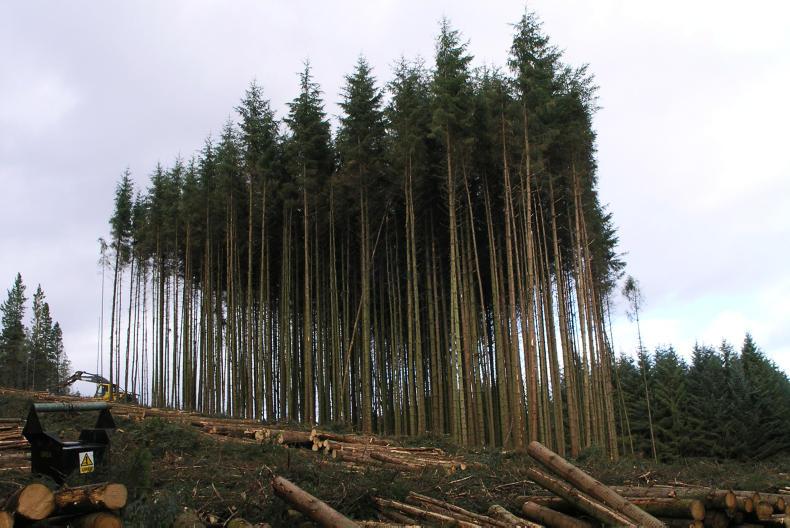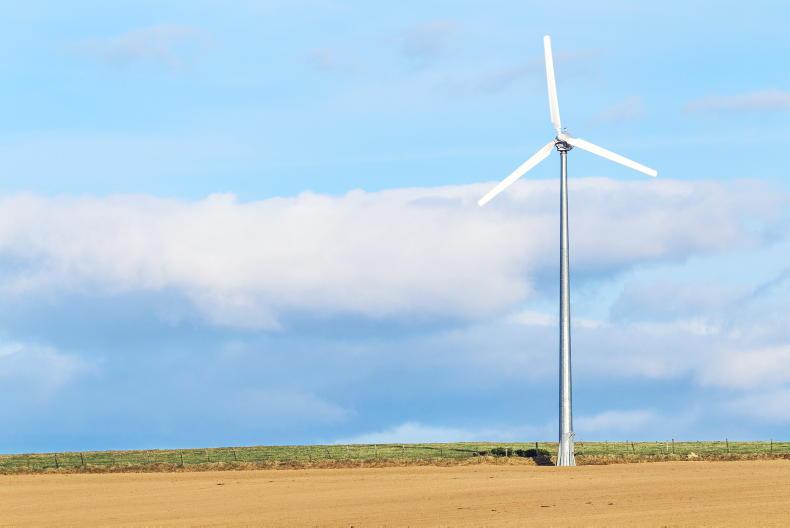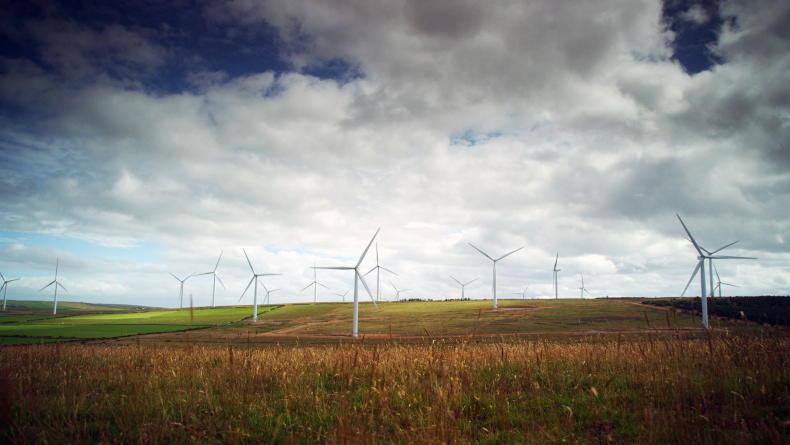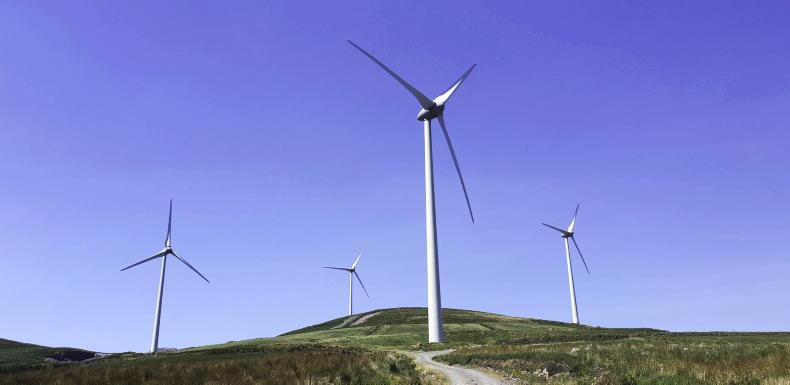Wood mobilisation, the sustainable harvesting and supply of timber from the forest to processors and end users, while recognised as a significant challenge, also offers huge opportunities.
Ireland’s expanding forest resource covers 11% of our land area. Over 70% of products from our modern sawmills and board mills are exported.
Private forestry
Demand for wood fibre is forecast to significantly exceed supply up to 2025 and beyond. Any future increase in harvest is forecast to come almost exclusively from private forestry.
Irish forests are a rapidly growing resource for renewable raw materials for use as wood fuels and in the production of a range of wood products.
The potential for added value products in the bio-economy is also a rapidly-developing area.
The emerging challenge is to sustainably increase the harvest of wood in order to satisfy growing consumer and processor needs.
The Irish forestry sector seeks to fully realise the multiple values of the forest asset and contribute to Ireland’s rural development and economic wellbeing.
Timber output to double
The COFORD All-Ireland Roundwood Production Forecast 2016-2035 anticipates that timber output will double in size by 2035, potentially achieving a volume of almost 8 million cubic metres (Figure 1).
This production will mainly come from farm forestry, which has been supported by grants and premiums from the Department of Agriculture.
The challenge within the sector is to ensure this doubling of volume output is achieved through best forest management and timely thinning of suitable forests to ensure a regular timber and biomass supply to appropriate markets.
The mobilisation of our forest resource will optimise benefits along the supply chain from forest owners through to end users.
Farm forest owners can help optimise the potential of their forests by assessing the progress of their timber crop time, preparing for thinning and timber marketing in good time and ensuring that harvesting and extraction is carried out in appropriate locations in an environmentally sustainable manner.
Co-ordination among forest owners
The supply of wood biomass requires well planned and efficient linages to be developed along the supply chain.
Almost 22,000 unique owners, 83% being farmers, own nearly half the forest area. The average forest size of these forests is under 9ha.
Fragmentation of plantations can pose a significant challenge in terms of access and costs.
However, there are major benefits to be gained by owners in working together.
Over the past decade, Teagasc has collaborated with local actors and helped facilitate the development of forest owner groups around Ireland.
A forest owner group can help achieve economies of scale by providing well-co-ordinated and shared services.

Forestry thinning at Roundwood, Co Wicklow.
Efficiencies and cost reductions can be achieved in road construction, harvesting and wood transportation.
It is easier to negotiate a reduction in the costs associated with thinning operations if larger quantities of material are sold.
The Department has also addressed the mobilisation of timber in a range of ways, including supporting of pilot Knowledge Transfer groups in 2017 and with wider rollout of the initiative proposed during 2018.
Forest roads and haulage
The timely planning of future access and construction of forest roads is critical to the operation and increases the value of forest plantations.
The location of roads must be carefully chosen to meet the landowner’s need for access, enable timber to be loaded, support the laden weight of lorries and for timber haulage lorries to turn.
The recent relaxation of the restriction on exempted development provisions for private roads serving forests and woodlands is very welcome news, which can provide impetus for further mobilisation of timber.
Previously, such roads could only be considered as exempt development if they did not provide access on to public roads.
Now such roads can be considered exempted development as long as they do not provide access to a national road within the meaning of the Roads Act 1993.
For wood biomass to be competitive in Ireland, it must be delivered to the energy plant or end user at the lowest cost possible
Haulage is a vital link in the timber and biomass supply chain. Approximately 65% of all forests are located in areas serviced by grade 4 roads.
Optimum routes need to be planned in advance, taking into consideration the requirements of planning authorities.
For wood biomass to be competitive in Ireland, it must be delivered to the energy plant or end user at the lowest cost possible.
Opportunities in the bio-economy
Around the world, industries of all kind produce waste. The "waste" from many agricultural and forestry industry activities have the potential for a second life as a valuable sidestream of the initial industry.
These products can not only have real value, but also add to a growing bio-economy that is both profitable and sustainable.
The Horizon2020-funded AgriForValor project has focused on bringing together members from all sectors adjacent to the bio-economy, helping identify where value can be found in sidestream products from agriculture and forestry and getting those feedstocks to innovators who transform them into valued commodities.
The technology now exists to create plastics from farm waste like grass and straw
The novel approach of the AgriForValor project is the identification of potential biomaterials that were formerly not considered valuable and the development of the technology needed to exploit them.
It aims to either save industries money or produce an ethical profit. For example, the technology now exists to create plastics from farm waste like grass and straw, and bark can be used to create insulation materials for example.
Initially three areas – Andalusia (Spain), Ireland and Hungary – were identified as potential project hubs.
These areas were chosen due to their high potential for production of sidestream by-products and a willingness to build a regional bio-economy.
The hubs were then designed, organised and staffed to bring together people from the fields of biomass sidestreams with people representing both regional and national levels of business, research and academia, as well as forest and agricultural sectors.

Forestry thinning at Roundwood, Co Wicklow.
The project’s findings were fed into an interactive web tool that can be used to browse the techniques and good practices online: the AgriForValor sidestream value tool.
The tool allows filtering on country, subsector, process, technology readiness level, biomass sidestream or output (fuel, food, feed, fertiliser, fine chemical, functional material).
It offers networking and marketing opportunities. All hands-on material is available for download.
Wood energy
There are three main sources of raw material for wood energy in the Republic of Ireland.
These include small roundwood (pulpwood or energy wood from thinnings), wood residues from the processing sector and post-consumer recovered wood.
There is also the potential to achieve additional biomass through harvesting of tree tips (from tip to 7cm diameter) and harvesting of tree branches and some harvest loss material (lop and top) on appropriate forest sites.
Based on a range of qualifying assumptions, the volume of wood fibre for energy, wood-based panels and other uses potentially available is set to increase from 1.8 million cubic metres in 2016 to almost 4.2 million cubic meters in 2035 (COFORD, 2015).
While much of this is currently in use in industrial applications or for energy generation, it may be possible to use this resource more efficiently and economically using a cascading approach.
This means that high-value products are first extracted from biomass, what remains is then further processed or reused in bulk materials, with the lowest-value materials used for production of biofuels and power.
Farm forest owners themselves can be the pioneers of emerging markets
This mobilisation of the private forest resource will optimise benefits along the supply chain from forest owners through to end users. Farm forest owners themselves can be the pioneers of emerging markets.
Teagasc will continue to play its role in assisting forest owners in getting the most from their forest, through the application of research, promotion of best practices, collaboration with industry partners and provision of advice and training to help ensure delivery of the huge growth potential of forestry.
Farmers and forest owners will get the opportunity to experience at first hand innovations in wood biomass application and timber mobilisation at Energy in Agriculture in Gurteen College, Co Tipperary, on 21 August.
Read more
Energy open day next Tuesday
Bright future for on-farm renewables
Pumping the heat
Rooftop solar scheme attractive for smaller farms
Wood mobilisation, the sustainable harvesting and supply of timber from the forest to processors and end users, while recognised as a significant challenge, also offers huge opportunities.
Ireland’s expanding forest resource covers 11% of our land area. Over 70% of products from our modern sawmills and board mills are exported.
Private forestry
Demand for wood fibre is forecast to significantly exceed supply up to 2025 and beyond. Any future increase in harvest is forecast to come almost exclusively from private forestry.
Irish forests are a rapidly growing resource for renewable raw materials for use as wood fuels and in the production of a range of wood products.
The potential for added value products in the bio-economy is also a rapidly-developing area.
The emerging challenge is to sustainably increase the harvest of wood in order to satisfy growing consumer and processor needs.
The Irish forestry sector seeks to fully realise the multiple values of the forest asset and contribute to Ireland’s rural development and economic wellbeing.
Timber output to double
The COFORD All-Ireland Roundwood Production Forecast 2016-2035 anticipates that timber output will double in size by 2035, potentially achieving a volume of almost 8 million cubic metres (Figure 1).
This production will mainly come from farm forestry, which has been supported by grants and premiums from the Department of Agriculture.
The challenge within the sector is to ensure this doubling of volume output is achieved through best forest management and timely thinning of suitable forests to ensure a regular timber and biomass supply to appropriate markets.
The mobilisation of our forest resource will optimise benefits along the supply chain from forest owners through to end users.
Farm forest owners can help optimise the potential of their forests by assessing the progress of their timber crop time, preparing for thinning and timber marketing in good time and ensuring that harvesting and extraction is carried out in appropriate locations in an environmentally sustainable manner.
Co-ordination among forest owners
The supply of wood biomass requires well planned and efficient linages to be developed along the supply chain.
Almost 22,000 unique owners, 83% being farmers, own nearly half the forest area. The average forest size of these forests is under 9ha.
Fragmentation of plantations can pose a significant challenge in terms of access and costs.
However, there are major benefits to be gained by owners in working together.
Over the past decade, Teagasc has collaborated with local actors and helped facilitate the development of forest owner groups around Ireland.
A forest owner group can help achieve economies of scale by providing well-co-ordinated and shared services.

Forestry thinning at Roundwood, Co Wicklow.
Efficiencies and cost reductions can be achieved in road construction, harvesting and wood transportation.
It is easier to negotiate a reduction in the costs associated with thinning operations if larger quantities of material are sold.
The Department has also addressed the mobilisation of timber in a range of ways, including supporting of pilot Knowledge Transfer groups in 2017 and with wider rollout of the initiative proposed during 2018.
Forest roads and haulage
The timely planning of future access and construction of forest roads is critical to the operation and increases the value of forest plantations.
The location of roads must be carefully chosen to meet the landowner’s need for access, enable timber to be loaded, support the laden weight of lorries and for timber haulage lorries to turn.
The recent relaxation of the restriction on exempted development provisions for private roads serving forests and woodlands is very welcome news, which can provide impetus for further mobilisation of timber.
Previously, such roads could only be considered as exempt development if they did not provide access on to public roads.
Now such roads can be considered exempted development as long as they do not provide access to a national road within the meaning of the Roads Act 1993.
For wood biomass to be competitive in Ireland, it must be delivered to the energy plant or end user at the lowest cost possible
Haulage is a vital link in the timber and biomass supply chain. Approximately 65% of all forests are located in areas serviced by grade 4 roads.
Optimum routes need to be planned in advance, taking into consideration the requirements of planning authorities.
For wood biomass to be competitive in Ireland, it must be delivered to the energy plant or end user at the lowest cost possible.
Opportunities in the bio-economy
Around the world, industries of all kind produce waste. The "waste" from many agricultural and forestry industry activities have the potential for a second life as a valuable sidestream of the initial industry.
These products can not only have real value, but also add to a growing bio-economy that is both profitable and sustainable.
The Horizon2020-funded AgriForValor project has focused on bringing together members from all sectors adjacent to the bio-economy, helping identify where value can be found in sidestream products from agriculture and forestry and getting those feedstocks to innovators who transform them into valued commodities.
The technology now exists to create plastics from farm waste like grass and straw
The novel approach of the AgriForValor project is the identification of potential biomaterials that were formerly not considered valuable and the development of the technology needed to exploit them.
It aims to either save industries money or produce an ethical profit. For example, the technology now exists to create plastics from farm waste like grass and straw, and bark can be used to create insulation materials for example.
Initially three areas – Andalusia (Spain), Ireland and Hungary – were identified as potential project hubs.
These areas were chosen due to their high potential for production of sidestream by-products and a willingness to build a regional bio-economy.
The hubs were then designed, organised and staffed to bring together people from the fields of biomass sidestreams with people representing both regional and national levels of business, research and academia, as well as forest and agricultural sectors.

Forestry thinning at Roundwood, Co Wicklow.
The project’s findings were fed into an interactive web tool that can be used to browse the techniques and good practices online: the AgriForValor sidestream value tool.
The tool allows filtering on country, subsector, process, technology readiness level, biomass sidestream or output (fuel, food, feed, fertiliser, fine chemical, functional material).
It offers networking and marketing opportunities. All hands-on material is available for download.
Wood energy
There are three main sources of raw material for wood energy in the Republic of Ireland.
These include small roundwood (pulpwood or energy wood from thinnings), wood residues from the processing sector and post-consumer recovered wood.
There is also the potential to achieve additional biomass through harvesting of tree tips (from tip to 7cm diameter) and harvesting of tree branches and some harvest loss material (lop and top) on appropriate forest sites.
Based on a range of qualifying assumptions, the volume of wood fibre for energy, wood-based panels and other uses potentially available is set to increase from 1.8 million cubic metres in 2016 to almost 4.2 million cubic meters in 2035 (COFORD, 2015).
While much of this is currently in use in industrial applications or for energy generation, it may be possible to use this resource more efficiently and economically using a cascading approach.
This means that high-value products are first extracted from biomass, what remains is then further processed or reused in bulk materials, with the lowest-value materials used for production of biofuels and power.
Farm forest owners themselves can be the pioneers of emerging markets
This mobilisation of the private forest resource will optimise benefits along the supply chain from forest owners through to end users. Farm forest owners themselves can be the pioneers of emerging markets.
Teagasc will continue to play its role in assisting forest owners in getting the most from their forest, through the application of research, promotion of best practices, collaboration with industry partners and provision of advice and training to help ensure delivery of the huge growth potential of forestry.
Farmers and forest owners will get the opportunity to experience at first hand innovations in wood biomass application and timber mobilisation at Energy in Agriculture in Gurteen College, Co Tipperary, on 21 August.
Read more
Energy open day next Tuesday
Bright future for on-farm renewables
Pumping the heat
Rooftop solar scheme attractive for smaller farms












SHARING OPTIONS